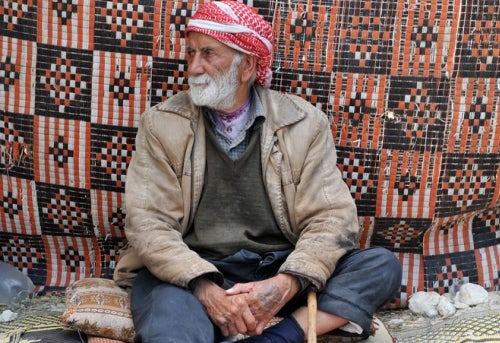 In terms of forced displacement relative to a country’s population,
Syria is among the worst tragedies since World War II . Nearly half of the country’s population has been forcibly displaced.
There are 4.8 million refugees, largely in neighboring Turkey (2.7 million), Lebanon (1.05 million) and Jordan (640,000). Over 1 million Syrians that have applied for asylum in Europe since 2011, with 900,000 applying in 2015. In addition there
are nearly 7 million internally displaced Syrians, accounting for 40% of the population still in Syria.
In terms of forced displacement relative to a country’s population,
Syria is among the worst tragedies since World War II . Nearly half of the country’s population has been forcibly displaced.
There are 4.8 million refugees, largely in neighboring Turkey (2.7 million), Lebanon (1.05 million) and Jordan (640,000). Over 1 million Syrians that have applied for asylum in Europe since 2011, with 900,000 applying in 2015. In addition there
are nearly 7 million internally displaced Syrians, accounting for 40% of the population still in Syria.
These are staggering numbers and much analysis has gone into the forced displacement issue, especially after the sudden massive influx into Europe in 2015. Aside from the broader issue of forced displacement, almost every demographic has received significant attention ranging from women, children, women, and young men. The one population group that has received relatively little attention has been the older refugee, which in this case refers to those 60 years and older as used by the UNHCR. Many remain active and a recent survey by the NGO HelpAge International and Handicap International showed that when elderly people are present in a family they are head of household in 6 out of ten cases and that 13% of households are headed by older people. Yet, while the vulnerabilities of older people generally stand out, much less recognized is their vital role within communities which goes beyond the immediate household and the multitude of assets that they bring to their traumatized communities.
Prior to the war, around 6% of Syria’s population of 22 million was over the age of 60 or around 1.5 million of its total population of 22 million. However, the proportion of those who are over 60 years old among refugees outside of Syria ranges from 2.5% in Lebanon to 3.2% in Turkey and 3.5% in Jordan. This is not a phenomenon unique to the Syrian war, a study from 2002 noted that older people “ hesitate to leave their communities even though staying places them at increased risk of injury and death…Pensions may stop, and their investment in housing, businesses, may be lost. Medical services such as primary healthcare, medications, and medical devices such as hearing aids needed for aging-associated diseases and impairments may not be available or deemed not to be a priority”. There are few figures on the proportion of older people among Syria’s displaced but it is likely to be higher than the ratio for refugees and there is some indication that they may figure disproportionally among those most affected by starvation and other ills in besieged Syrian towns and neighborhoods.
The most visible aspect of vulnerability for older refugees is health care and with health care requiring significant outlays of funds especially in Lebanon but also in Jordan this becomes a critical issue since many older people forego their treatment to pass on savings to their families. In Turkey, while health care is available for free to registered Syrian refugees, language looms as a significant barrier. A survey in Lebanon noted that “Two-thirds of older refugees described their health status as poor or very poor. with 60% having hypertension, 47% reporting diabetes, 30% indicating some form of heart disease. Difficulties in affording medicines were reported by 87%...47% reported difficulty walking and 24% reported vision loss. 10% were physically unable to leave their homes and 4% were bedridden”. Older refugees also tend to be less well fed , often because they pass on more nutritious food to their families and they also report higher rates of mental health problems. Access to services whether via appropriate transport, shelter or by navigating through bureaucratic labyrinths can also be especially challenging.
Yet while it is true that in the desperate situation that these communities face, scarce resources from within the community and from outside providers of assistance tend to flow to children and their mothers, there is a case beyond the humanitarian one for also providing more resources to older refugees since they bring assets that benefit the whole community: “ Older persons tend to garner more respect and are able to be more effective negotiators with the host community. They also tend to have a positive effect on other members' mental health and can provide assistance with child care and household chores”. Older people are also better placed to adjudicate disputes within refugee communities while often extending child care to more than one household. Also, half of the over 60 population in the developing world continues to work, often till their late seventies. In short they remain a vital part of any community and while their vulnerabilities are clear, the assets that they bring can be critical in enhancing the wellbeing and livelihood of refugee communities.
In recognition of this critical role, the UNHCR advocates that staff of humanitarian and other aid agencies understand the different capacities and contributions that older people play in displaced families and communities and ensure that outside interventions do not undermine these roles whether they be in child care or mediation or counselling. The UNHCR also advocates for giving older people greater voice and active roles in the community given their usually more measured and reasoned approaches. It also urges for a role for older refugees who care for children in child protection programs. Indeed, rather than an afterthought it is time to focus a bit more directly to this demographic who can immeasurably strengthen the resilience of these battered communities.


Join the Conversation